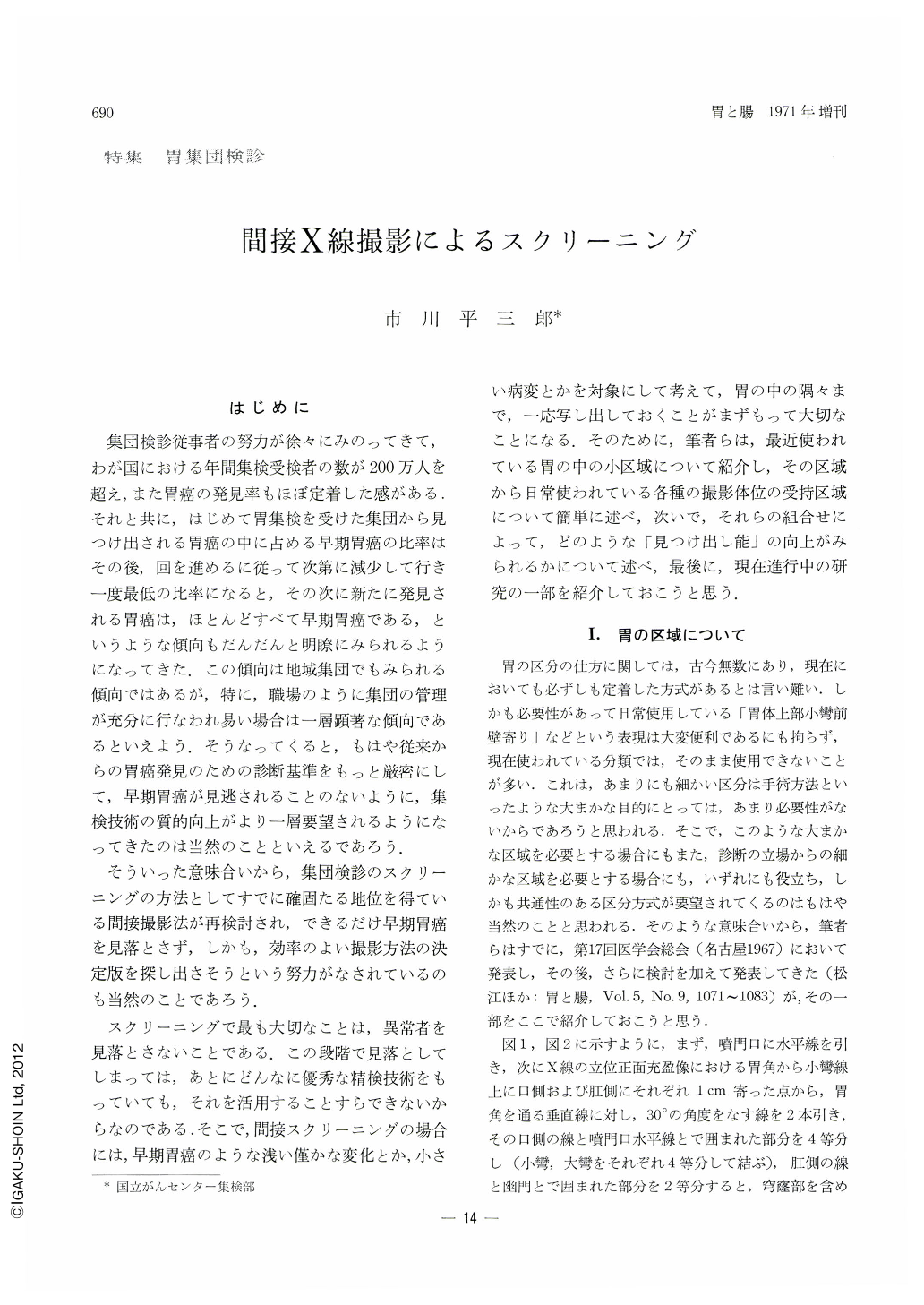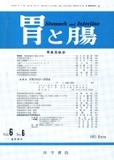Japanese
English
- 有料閲覧
- Abstract 文献概要
- 1ページ目 Look Inside
はじめに
集団検診従事者の努力が徐々にみのってきて,わが国における年間集検受検者の数が200万人を超え,また胃癌の発見率もほぼ定着した感がある.それと共に,はじめて胃集検を受けた集団から見つけ出される胃癌の中に占める早期胃癌の比率はその後,回を進めるに従って次第に減少して行き一度最低の比率になると,その次に新たに発見される胃癌は,ほとんどすべて早期胃癌である,というような傾向もだんだんと明瞭にみられるようになってきた.この傾向は地域集団でもみられる傾向ではあるが,特に,職場のように集団の管理が充分に行なわれ易い場合は一層顕著な傾向であるといえよう.そうなってくると,もはや従来からの胃癌発見のための診断基準をもっと厳密にして,早期胃癌が見逃されることのないように,集検技術の質的向上がより一層要望されるようになってきたのは当然のことといえるであろう.
そういった意味合いから,集団検診のスクリーニングの方法としてすでに確固たる地位を得ている間接撮影法が再検討され,できるだけ早期胃癌を見落とさず,しかも,効率のよい撮影方法の決定版を探し出さそうという努力がなされているのも当然のことであろう.
スクリーニングで最も大切なことは,異常者を見落とさないことである.この段階で見落としてしまっては,あとにどんなに優秀な精検技術をもっていても,それを活用することすらできないからなのである.そこで,間接スクリーニングの場合には,早期胃癌のような浅い僅かな変化とか,小さい病変とかを対象にして考えて,胃の中の隅々まで,一応写し出しておくことがまずもって大切なことになる.そのために,筆者らは,最近使われている胃の中の小区域について紹介し,その区域から日常使われている各種の撮影体位の受持区域について簡単に述べ,次いで,それらの組合せによって,どのような「見つけ出し能」の向上がみられるかについて述べ,最後に,現在進行中の研究の一部を紹介しておこうと思う.
It has been 15 years since mass survey for stomach cancer by means of indirect radiography was first employed in Japan. Since then the number of films per examinee has increased and positionings have been improved. However, according to recent investigations, these vary very much by each group of examiners. More than 66 different combinations of position with varying amount of barium are now used all over the country.
As one of the most effective approaches to a model of what an indirect radiography should be for gastric mass survey in which every segment of the stomach can be visualized to the best advantage, the author has introduced a new attempt to divide the whole areas of the stomach into '77 sections, thereby making it more convenient to describe accurately any of these areas. It is a means to determine what positioning would be most responsible for visualizing a certain thus divided section of the stomach. By combining several most appropriate positionings for each examinee, one is able to cover all sections of the stomach for one examination. Theoretically speaking and from this point of view, seven exposures are at least necessary for each person. They are illustrated in Figs. 1 to 11.
The author also launched two experimental studies: the one consists of 34-exposure method as applied to 29 cases of early gastric cancer of different size and location already confirmed at the National Cancer Center; and the other, Of 17-exposure method tried on 144 cases of early gastric cancer likewise experienced in 12 different leading institutions in this country. These films have been read by experts in this field to check in which of exposures are abnormal findings present. The results, analyzed by electronic computer, have yielded ver yinteresting data.
These experimental studies have revealed that the most effective method of mass examination must include at least the five following positionings: (1) supine right anterior (double contrast), (2) prone with stomach filled with barium, (3) supine frontal (double contrast), (4) prone with a very small amount of barium (mucosal study) and (5) upright frontal with the stomach filled with barium.
Based on the above-mentioned data, standard positionings and their combinations shall be shown in the near future with due consideration of economy in time and cost of examination.
Some parts of this paper were reported in the 28 th Annual Meeting of the Iapanese Society (1969) and the 8th Autumn Meeting of the Japanese Society of Gastric Mass Survey (1970).
This study was supported by the budget of Japanese Ministry of Health and Welfare for supporting Cancer Research.

Copyright © 1971, Igaku-Shoin Ltd. All rights reserved.


